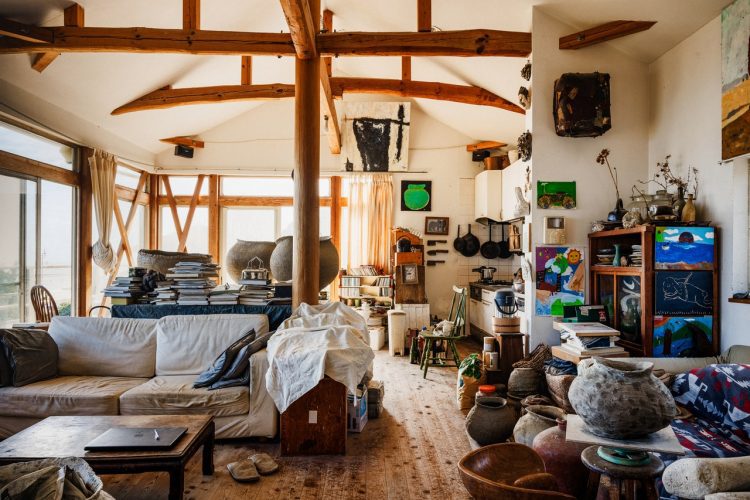Maybe it’s a reaction to the years of hypercapitalist excess we’ve all grown accustomed to, or maybe it’s the inevitable result of having had our lives rearranged and our brains rewired by a pandemic, but nature and craft feel more essential than ever when it comes to the way we live.
As the Japanese artist Kazunori Hamana puts it simply, “We humans are a part of nature.” His home, in Isumi, perched 50 meters from the Pacific Ocean, is the perfect example of how the harmony between nature and craft can fill a room with comfort and intrigue. His studio—built solidly in the Japanese wood-frame tradition and filled with the natural clay pots Hamana makes—balances creative expression with sturdy simplicity.
Artist and arborist Ido Yoshimoto’s love for nature was first expressed through building tree forts and rope swings under the local canopies of Northern California—now it comes through in the large-scale wood carvings he makes from the trunks of fallen trees. His open-air workspace was originally built by the legendary artist J.B. Blunk and is full of unique, hand-carved details from decades ago. “I’m sure I subconsciously absorb these shapes and aesthetic sensibility by being in and around them,” Yoshimoto says.
Salmon Creek Farm proposes another way to live in unity with the California redwoods. This old hippie commune has been reimagined by the artist Fritz Haeg as a colony for those in search of a back-to-the-land style of living. Haeg built the kitchen in Cabin #1 Orchard himself. “There’s no conventional kitchen cabinetry,” he says, “no stainless, no drywall, and no pantry of canned goods.”
Maverick builder SunRay Kelley is a legend of the handmade, vernacular architecture scene from which Salmon Creek springs. His rolling homes (in his words: “Gypsy Wagons”) are compressed versions of his fantastical cabin and tree house designs—more Ken Kesey than Winnebago. Kelley wants these psychedelic motor homes, which incorporate solar power and wooden walls, to serve as object lessons for a sustainable path forward. “I have great hopes that we can turn the tide of environmental degradation,” he says.
The late, great George Nakashima also had a vision for sustainable design—and a premonition, back in the ’70s, that nature would be much happier if we stopped extracting its fossil fuels. For his iconic Reception House bathroom on his Pennsylvania estate, he built a creative tub that relied on a wood-burning boiler. Stoking the fire to heat the water could take hours, Mira Nakashima, George’s daughter, says, so long soaks were in order.
Maine-based designer and builder Anthony Esteves knows a thing or two about the importance of staying warm. His scrap sauna, built entirely of salvaged materials, save for the metal chimney, heats to above 160 Fahrenheit. Esteves says, “It’s a place for us to gather with friends and family and create warmth in the cold months.”
These six unique rooms are sanctuaries, designed with nature, history, and craft in mind. Something we can all use more of in our lives.
Source by www.gq.com


